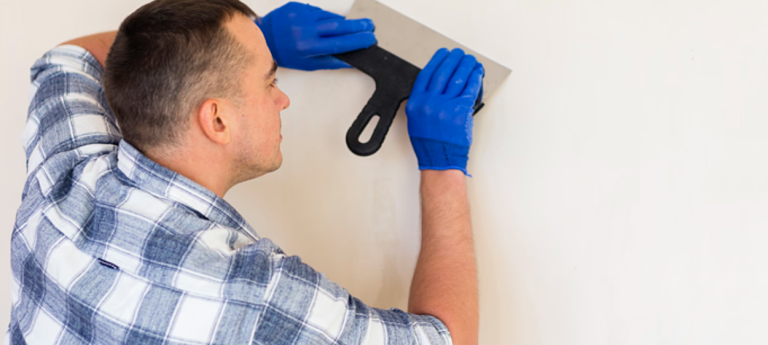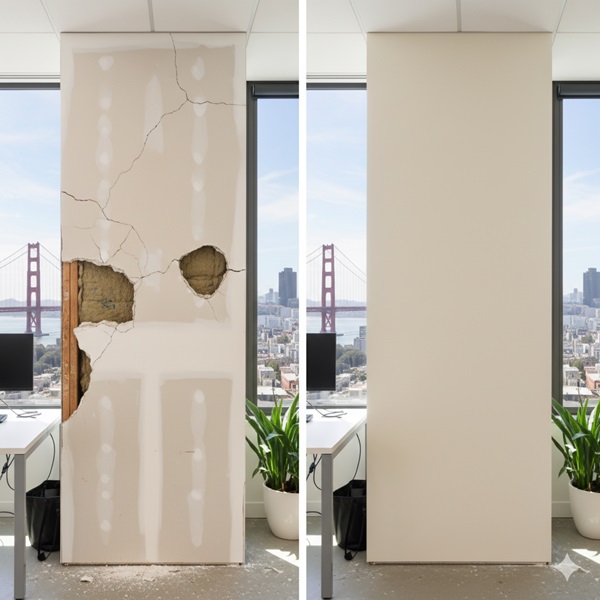A Comprehensive Guide to Mastering Drywall Repair and Installation
This overview supplies an extensive expedition of drywall fixing and installment, satisfying both newbies and experienced professionals. It describes vital tools, strategies for patching and hanging sheets, and the important ending up procedures. drywall contractor. By comprehending common pitfalls, individuals can accomplish sleek results. Mastering these abilities not only enhances one's home but also builds confidence in DIY endeavors. What foundational pointers will ensure an effective task from start to end up?
Essential Devices for Drywall Fixing and Installation
When beginning on drywall repair work and setup, a couple of vital tools can substantially enhance the effectiveness and high quality of the job. A drywall blade, typically available in different dimensions, is essential for using joint compound and smoothing joints. A taping knife is additionally necessary for feathering sides and making certain a smooth coating. Furthermore, a drywall saw or energy knife enables accurate cutting of drywall sheets to fit any type of room.

Step-by-Step Guide to Patching Holes
Patching holes in drywall is a straightforward procedure that can recover the wall's look and honesty. To start, the area around the hole must be cleaned and any kind of loosened particles got rid of. For tiny openings, a simple spackle or joint substance can be used with a putty blade. Bigger openings might require a spot; a piece of drywall can be reduced to fit the hole, protected with adhesive or screws, and then taped around the sides. As soon as the spot is in location, joint substance is used over the spot and feathery out to blend with the bordering wall. After the compound dries out, sanding is necessary to attain a smooth coating. The fixed location can be keyed and repainted to match the rest of the wall surface. This method assures a smooth repair, enhancing the overall appearance of the drywall and maintaining its architectural integrity.
Methods for Hanging Drywall Sheets
After successfully fixing holes in drywall, the following action involves hanging new drywall sheets to create a smooth surface area. To attain this, one need to start by determining the wall surface area precisely and cutting the drywall sheets to fit. It is important to hang the sheets horizontally for much better architectural stability, beginning with the top and working downwards.
Utilizing a drywall lift can streamline the procedure, especially for ceiling installments. Once positioned, safeguarding the sheets with drywall screws at intervals of concerning 12 inches along the edges and 16 inches in the area is necessary. This assures a solid hold and lowers the risk of drooping. For corners, the sheets need to be cut to fit comfortably, permitting cleaner seams. It is advisable to startle the joints between sheets to reinforce the overall structure, developing a more resilient finish prepared for the next stage in the drywall installation procedure.
Completing Touches: Taping and Mudding
Completing the drywall setup entails the vital actions of mudding and taping, which guarantee a refined and smooth coating. Taping requires the application of joint tape over the joints between drywall sheets. drywall contractor. This tape can be either paper or fiberglass harmonize, with each type offering distinct benefits. After taping, the next action is mudding, where joint compound, or "mud," is used to cover the tape and load any kind of flaws
Using a drywall blade, the substance ought to be spread out uniformly, making certain a feathered side to reduce visible changes. Multiple layers are usually required, with fining sand in between each layer to achieve a seamless surface. Cautious attention during this procedure click to read more is vital, as it considerably impacts the final look of the wall surface. With the right method and perseverance, completion outcome will certainly be a remarkable foundation prepared for paint or ending up touches.
Common Errors to Stay Clear Of in Drywall Projects

An additional common blunder is not allowing enough drying out time in between layers, which can catch dampness and compromise the finish. Additionally, overlooking to feather the sides properly can produce noticeable lines and flaws. Avoiding sanding or utilizing inappropriate strategies may leave rough areas. By recognizing these challenges, people can significantly boost the top quality of their drywall projects and achieve a professional-looking surface.
Regularly Asked Questions
Can I Fix Drywall Without Expert Aid?
Yes, one can fix drywall without expert help. With the right tools, materials, and assistance, individuals can effectively handle small repair work. Substantial damage might require professional proficiency for optimal results and sturdiness.
For How Long Does Drywall Substance Take to Dry?
Drywall compound normally takes in between 24 to 48 hours to completely dry totally, depending on variables such as humidity and temperature. Thinner layers may dry out much faster, while thicker applications need more time for excellent results.
What's the very best Kind Of Paint for Drywall?
The very best kind of paint for drywall is typically a water-based latex paint. It supplies excellent insurance coverage, durability, and ease of application, making it ideal for interior walls while enabling simple clean-up with soap and water.

Just how Do I Avoid Mold And Mildew on Drywall?
To avoid mold and mildew on drywall, assurance correct ventilation, control moisture degrees, use mold-resistant materials, and promptly deal with any type of leakages. Routine assessments and prompt remediation of water damages are also necessary for long-lasting prevention.
Is Drywall Recyclable After Removal?
Drywall is recyclable after elimination, gave it is devoid of contaminants like mold, paint, Go Here or various other harmful materials. Reusing facilities can process it into brand-new products, advertising try this web-site sustainability and reducing land fill waste in construction.
When beginning on drywall repair and installment, a couple of necessary tools can significantly improve the performance and quality of the job. After effectively repairing holes in drywall, the following action includes hanging new drywall sheets to develop a seamless surface area. Completing the drywall installation includes the essential actions of taping and mudding, which guarantee a polished and smooth coating. Accomplishing a sleek finish in drywall projects can be challenging, and several usual blunders can threaten the top quality of the job. Yes, one can fix drywall without professional assistance.